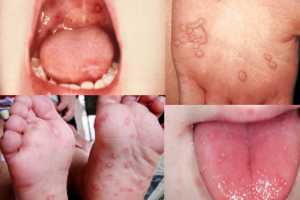Today on the emDOCs cast with Brit Long, MD (@long_brit), we cover the literature on evaluation and management of massive hemoptysis.
Episode 116: Massive Hemoptysis
Definition:
- Hemoptysis is expectoration of blood from the respiratory tract; ranges from mild with small streaks of blood to cardiopulmonary compromise (1-5).
- Massive hemoptysis: no clear definition, ranges from 50 mL in a single expectoration to 100 mL in 24 hours to over 1 L in 48 hours.
- Instead of the amount, think about the following: Does this look like a lot? Is it impacting patient respiratory (hypoxemia, respiratory distress), mental (altered), and cardiovascular status (unstable)? Are they unable to clear the blood? If yes => Massive hemoptysis (1-5).
Pathophysiology:
- Two distinct vascular supplies in the pulmonary system: bronchial and pulmonary arteries.
- Pulmonary arteries (right side) are responsible for the majority of the pulmonary blood supply. Low pressure, blood from right heart to alveoli for oxygen/CO2 exchange, then returns to left heart.
- Bronchial arteries (left side) provide blood to the pulmonary system (also hilar lymph nodes, visceral pleura, vagus nerve, and esophagus) under high pressure, but are not involved in gas exchange.
- MH comes from the bronchial arteries in over 90% of cases (1-6).
- Anatomic dead space is approximately 150 mL. Small amount of blood can compromise oxygenation and ventilation => rapid decompensation.
- Physiologic dead space higher in chronic lung disease (COPD).
- Asphyxiation is the primary cause of death in MH, not exsanguination.
Epidemiology:
- Prevalence of hemoptysis ranges between 0.2-14%. Wide range in numbers for MH.
- Studies from the 1980s and 1990s found 5-14% of patients with hemoptysis had a life-threatening event (7,8).
- Another study found 30% of patients presented with moderate hemoptysis, defined as 20-500 mL in this study, and approximately 2% had MH, defined in this study as > 500 mL (9).
- Prior to current therapies, mortality rates ranged between 50-100%. More current numbers suggest rate between 6-38% (1-3,10-15).
Etiologies:
- Any factor associated with airway or pulmonary parenchymal damage or increased bleeding increases risk of hemoptysis.
- Tuberculosis is most common cause worldwide.
- In places where TB is not endemic, most common causes are bronchiectasis, bronchogenic carcinoma, mycetoma.
- Up to 20% of patients with lung cancer will experience an episode of hemoptysis (MH occurs in about 3%) (12).
- Other causes: vascular (tracheo-innominate fistula, aortobronchial fistula, pulmonary embolism), severe autoimmune diseases (alveolar hemorrhage), and iatrogenic.
- Annual incidence of MH in patients with cystic fibrosis is 0.9-4.1% (16).
- Source of bleeding is unknown in up to 25% of patients.
Presentation:
- History needs to focus on the severity of bleeding and other findings that can help determine etiology (if able to obtain): tuberculosis, tobacco use, autoimmune disease, cancer, emphysema, pulmonary vascular disease, recent surgery, recent infection, anticoagulant use, and illicit drug.
- History of or current large amounts of expectorated blood and respiratory or hemodynamic compromise with hypotension and tachycardia. Even 50 mL can lead to respiratory complications.
- Bleeding from other sources: coffee-ground emesis, history of vomiting, gingivitis, findings of chronic liver disease, and nasopharyngeal abnormalities.
- Severe dyspnea, chest pain, fever, chills, rigors, weight changes, hematuria, and poor oral intake (based on etiology).
- May be in respiratory failure (failure to oxygenate/ventilate), altered, hemodynamically unstable.
- Severe amount of blood in the lungs: respiratory distress and hypoxemia.
- Concerning signs and symptoms: accelerating or continued large volume hemoptysis, altered mental status, hypoxemia, respiratory distress or failure, inability to clear their secretions, and hemodynamic compromise.
Imaging:
- Start with bedside chest x-ray.
- Simple, fast, can assist in evaluating for the site of bleeding and other pulmonary abnormalities.
- Literature suggests it may identify the source in 33-82% of cases, but 20-40% of studies falsely negative (1-5).
- POCUS can also assist to evaluate the affected side.
- CT is an integral component of evaluation if patient can undergo dedicated imaging.
CT:
- CTA with pulmonary arterial phase contrast is the test of choice. Evaluates lung parenchyma and thoracic vasculararchitecture, aids in identifying the site and specific cause of bleeding in MH. Can be used for embolization.
- Discuss with the radiologist first; the image acquisition and timing of contrast bolus is different the typical pulmonary artery CT angiogram used for pulmonary embolism. Arterial phase imaging focuses on the bronchial arterial system.
- Over time, bleeding into the lung can obscure the source of bleeding; reduces CTA accuracy and sensitivity
- Ensure they are safe for CTA first: Are they are able to lie flat without aspirating blood? Do they have a perfusing blood pressure? Are they alert enough to follow commands? Are they able to protect their airway? If yes, obtain CTA. If not, emergent bronchoscopy is test of choice.
Management:
- Major components: evaluating their airway and ensuring they can manage their secretions, managing hemodynamic compromise and coagulopathy, imaging, specialty consultation, and medical therapy.
Airway:
- Key decision: base decision for intubation on clinical course, efficacy of airway clearance (coughing, mental status), ED/institutional resources, respiratory status (respiratory failure).
- Avoid intubation for those with adequate cough, clearing their own airway, alert, stable. Spontaneous coughing is the best means of airway clearance.
- Trend over time is important.
- Consider HFNC in those with respiratory distress who are alert and can maintain their airway.
- Avoid noninvasive positive pressure ventilation devices with full facemask; do not allow spontaneous clearance.
- Intubation necessary in those with increased work of breathing with hypoxemia/tachypnea, altered mentation, and inability to clear their airway.Avoid if possible!
- Anatomically and physiologically difficult airway; use the most experienced clinician with a technique with the highest chance of success.
- Avoid HOP killers: hypotension, hypoxemia, acidemia. Resuscitate prior to intubation.
- Preparation: dual large bore suction devices, full PPE, push dose pressors, prep for soilage of airway device, multiple devices, prep for cricothyrotomy.
- Avoiding soilage of VL camera: Raise HOB 30-45 degrees, remain “high” in the airway and lead with suction while keeping blade as anterior as possible. Use large bore suction if possible. Avoid “scoop and lift”. Instead, slide the blade along the tongue surface into the vallecula with constant, upward, anterior pressure.
- Use large bore ETT (>8.0 mm if possible). Assists with bronchoscopy and endobronchial blocker if needed. Avoid double-lumen ETT: optimal placement difficult, easy to malposition, makes bronchoscopy more difficult.
- Steps after intubation:
- Aggressively suction (both within the endotracheal tube and deep suction, generally performed with flexiblesuction catheter).
- Place patient in lateral decubitus position with bleeding lung down. Reduces ventilation-perfusion mismatch and risk of aspiration in the non-affected lung. If bleeding from both lungs, place patient in reverse Trendelenburg position or partially sitting upright.
- If bleeding continues, can intubate non-affected side. Bronchoscopy is best if possible. If not, blind advancement of ETT into the right mainstem bronchus can be performed if the left side is bleeding. If it’s the right side that’s bleeding, place a bougie with the angulated tip facing left, then advance the ETT. Rotate patient’s head opposite the desired side (toward bleeding side) can assist.
- Obtain post intubation x-ray.
- If ventilating both sides, target TV 6-8 mL/kg of predicted body weight. If ventilating single lung, use 3-4 mL/kg with higher RR to reduce barotrauma.
Managing Coagulopathy:
- Review medications; check CBC, coagulation panel, fibrinogen level.
- Key: morbidity and mortality are due to asphyxiation, not blood loss primarily.
- Blood products are recommended in those with hypovolemia, cardiovascular compromise, coagulopathy.
- Warfarin: vitamin K 10 mg IV and PCC or FFP.
- DOACs: aPCC or specific reversal agent (andexanet alfa for apixaban and rivaroxaban; idarucizumab for dabigatran).
- Platelets for those with counts < 50,000/microL.
- If on antiplatelet agent (e.g., aspirin) or history of renal failure, consider desmopressin 0.3 microg/kg IV.
- Fibrinogen level < 150 mg/dL: cryoprecipitate or fibrinogen concentrate (not FFP).
- TXA may be helpful based on limited data (most studies exclude MH).
- A 2018 RCT included 47 patients with hemoptysis (excluded MH) evaluated nebulized TXA three times per day compared to normal saline and found reduced expectorated blood volume, greater chance of hemoptysis resolution (96% versus 50%), shorter hospital LOS, less need for procedures for hemoptysis control (0% vs. 18.2%) (17).
- A 2023 RCT evaluated 100 stable patients with hemoptysis receiving TXA 500 mg IV or nebulized 3 times per day.Hemoptysis cessation at 30 minutes in 72.7% of the nebulized-TXA arm vs 50.9% of the IV-TXA arm. Patients in the nebulized-TXA arm had a greater decrease in the amount of hemoptysis, lower rates of IR procedures, and lower rates of admission (32.1% vs 61.0%) (18).
- Other studies are small series/case reports.
- Overall less bleeding, need for intervention, and blood product transfusion. TXA is cheap and likely safe.
- Dosing: 500-1000 mg nebulized, followed by 500 mg every 8 hours. If cannot tolerate a nebulizer or clear secretions, administer TXA 1-2 g IV.
- TXA administration should not delay other interventions.
What are other key parts of management?
- Consultation needed for definitive management: Pulmonology/critical care, IR, and cardiothoracic surgery; admission to the critical care setting (likely requires transfer).
- Definitive therapy may include embolization, bronchoscopy, or surgical resection.
- Bronchial artery embolization (IR):
- Effective in 80-100% of cases. Reduces mortality and duration of mechanical ventilation.
- Bleeding may recur in 10-57% of patients; large central masses difficult to embolize (19-22).
- Bronchoscopy (Pulmonology/critical care):
- Used in intubated patients, those too unstable for CT despite resuscitation, or if the source of bleeding is not clear despite other imaging (CT).
- Bronchoscopy can localize and define a bleeding source and remove obstructing clots from the airway (improve gas exchange and hypoxemia).
- Use a therapeutic bronchoscope or bronchoscope with a large diameter working channel to ensure suctioning is possible during the procedure.
- Bronchoscopy can be used for bleeding control with cold saline, epinephrine, activated factor VIIa, or TXA.
- Endobronchial blocker can be placed if bleeding is localized to a specific location in the lung in a bronchus; goal is to contain the bleed and protect pulmonary tissue. Need sedation with or without paralysis to prevent coughing or endobronchial blocker dislodgement.
- Avoid disturbing areas that are hemostatic.
- Surgical resection (Cardiothoracic surgery):
- Option is localized bleeding is refractory to other therapies and patient can tolerate a resected section.
- Not often required because of the effectiveness of bronchial artery embolization and bronchoscopy.
- Poor candidates: underlying pulmonary disease like COPD, lung cancer, bronchiectasis.
- Optimal candidates: previously healthy with a specific bleeding site.
- Bronchial artery embolization (IR):

Summary:
- MH is any bleeding from the tracheobronchial tree that compromises respiratory or circulatory function. Most common cause is tuberculosis worldwide. In the U.S., most common causes include bronchiectasis, bronchogenic carcinoma, and mycetoma.
- Asphyxiation is the most common cause of death. The tracheobronchial tree has a low volume, and even 150 mL of bleeding within the tracheobronchial tree can lead to respiratory failure.
- Altered mental status, respiratory distress (hypoxemia, tachypnea), inability to clear secretions, and hemodynamic compromise are concerning for decompensation in patients with MH.
- CTA with pulmonary arterial phase is the imaging modality of choice; 20-40% of chest radiographs will be falsely negative.
- Management includes airway assessment, reversing any coagulopathy, and emergent consultation of a multidisciplinary team. Nebulized TXA may be attempted, though if the patient cannot tolerate nebulization or cannot clear secretions, the IV route should be utilized.
- Clinicians should avoid intubating patients who can clear their airway, as coughing is more effective in airway clearance as opposed to suction.
- If the patient is intubated, an 8.0 mm or greater ETT is recommended if possible, with frequent suctioning and lung isolation if possible.
- Other therapies include bronchial artery embolization, bronchoscopy, and surgery. Consult pulmonology/critical care, interventional radiology, and cardiothoracic surgery, which may mean transfer.
References:
- Pirotte M, Pirotte A, Koyfman A, Long B. High risk and low incidence diseases: Massive hemoptysis. Am J Emerg Med. 2024 Nov;85:179-185.
- Atchinson PRA, Hatton CJ, Roginski MA, Backer ED, Long B, Lentz SA. The emergency department evaluation and management of massive hemoptysis. Am J Emerg Med. 2021 Dec;50:148-155.
- Davidson K, Shojaee S. Managing Massive Hemoptysis. Chest. 2020;157(1):77-88.
- Radchenko C, Alraiyes AH, Shojaee S. A systematic approach to the management of massive hemoptysis. J Thorac Dis. 2017;9(Suppl 10):S1069-S1086.
- Gagnon S, Quigley N, Dutau H, Delage A, Fortin M. Approach to Hemoptysis in the Modern Era. Can Respir J. 2017;2017:1565030.
- Ittrich H, Bockhorn M, Klose H, et al. The Diagnosis and Treatment of Hemoptysis. Dtsch Arztebl Int. 2017;114:371-81.
- Hirshberg B, Biran I, Glazer M, Kramer MR. Hemoptysis: etiology, evaluation, and outcome in a tertiary referral hospital. Chest. 1997 Aug;112(2):440-4.
- Johnston H, Reisz G. Changing spectrum of hemoptysis. Underlying causes in 148 patients undergoing diagnostic flexible fiberoptic bronchoscopy. Arch Intern Med. 1989 Jul;149(7):1666-8.
- Mondoni M, Carlucci P, Job S, et al. Observational, multicentre study on the epidemiology of haemoptysis. Eur Respir J. 2018 Jan 4;51(1):1701813.
- Fartoukh M, Khoshnood B, Parrot A, et al. Early prediction of in-hospital mortality of patients with hemoptysis: an approach to defining severe hemoptysis. Respiration. 2012;83(2):106-14.
- Razazi K, Parrot A, Khalil A, et al. Severe haemoptysis in patients with non-small cell lung carcinoma. Eur Respir J. 2015 Mar;45(3):756-64.
- Kvale PA, Selecky PA, Prakash UB, et al. Palliative care in lung cancer: ACCP evidence-based clinical practice guidelines (2nd edition). Chest 2007;132:368S-403S.
- Knott-Craig CJ, Oostuizen G, Rossouw G, et al. Management and prognosis of massive hemoptysis: recent experience with 120 patients. J Thorac Cardiovasc Surg 1993;105:394-7.
- Mal H, Rullon I, Mellot F, et al. Immediate and long-term results of bronchial artery embolization for life-threatening hemoptysis. Chest 1999;115:996-1001.
- Lee TW, Wan S, Choy DK, et al. Management of massive hemoptysis: a single institution experience. Ann Thorac Cardiovasc Surg 2000;6:232-5.
- Flume PA, Yankaskas JR, Ebeling M, et al. Massive hemoptysis in cystic fibrosis. Chest 2005;128:729-38.
- Wand O, Guber E, Guber A, et al. Inhaled Tranexamic Acid for Hemoptysis Treatment: A Randomized Controlled Trial. Chest. 2018 Dec;154(6):1379-1384.
- Gopinath B, Mishra PR, Aggarwal P, Nayaka R, Naik SR, Kappagantu V, Shrimal P, Ramaswami A, Bhoi S, Jamshed N, Sinha TP, Ekka M, Kumar A. Nebulized vs IV Tranexamic Acid for Hemoptysis: A Pilot Randomized Controlled Trial. Chest. 2023 May;163(5):1176-1184.
- Shao H, Wu J, Wu Q, et al. Bronchial Artery Embolization for Hemoptysis: A Retrospective Observational Study of 344 Patients. Chin Med J (Engl). 2015;128(1):58-62.
- Ghanaati H, Shakouri Rad A, Firouznia K, Jalali AH. Bronchial Artery Embolization in Life-Threatening Massive Hemoptysis. Iran Red Crescent Med J. 2013;15(12).
- Tom LM, Palevsky HI, Holsclaw DS, et al. Recurrent Bleeding, Survival, and Longitudinal Pulmonary Function following Bronchial Artery Embolization for Hemoptysis in a U.S. Adult Population. Journal of Vascular and Interventional Radiology. 2015;26(12):1806-1813.e1.
- Panda A, Bhalla AS, Goyal A. Bronchial artery embolization in hemoptysis: a systematic review. Diagn Interv Radiol. 2017;23(4):307-317.







